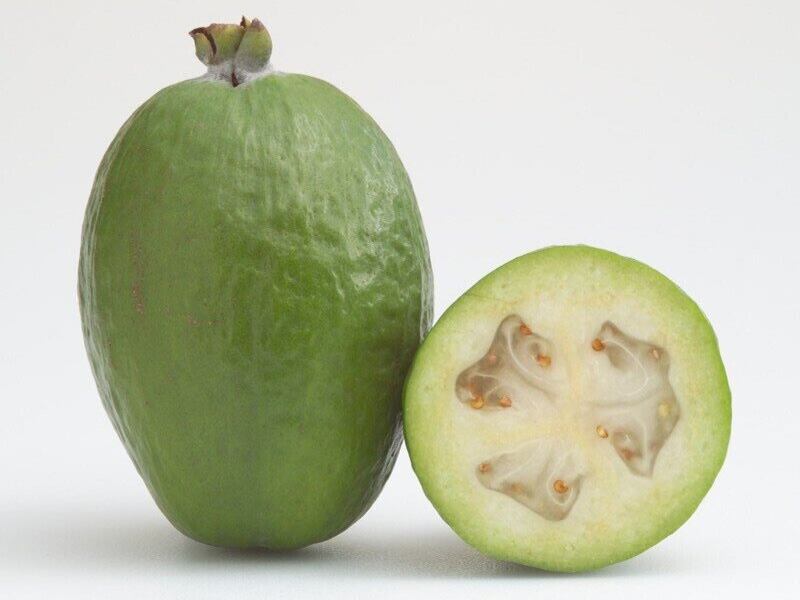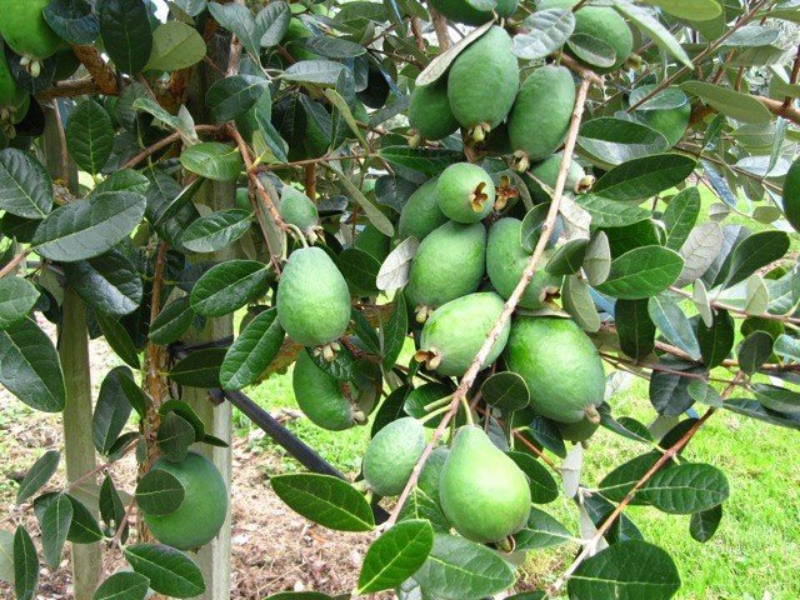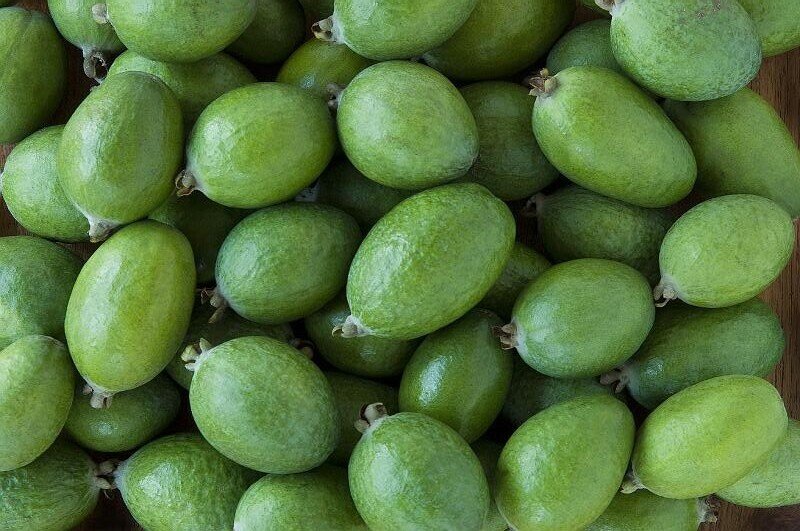Here are 19 interesting and fun facts about feijoas, often called green gold in New Zealand.
I’m going to say at least three of these facts will be new to you…the feijoa has a cult following in NZ, but we don’t even know that much about them. So here we go with…
19 FACTS ABOUT FEIJOAS

1. The feijoa is also known as pineapple guava, and guavasteen.
2. The feijoa originates from South America but can now be found in subtropical/tropical places with cold winters that are less than 1000 metres below sea level. The cold winters are needed for the development of the flowers which need about 50 days of freezing temperatures to develop.
3. In addition to being grown as a tree providing food, people have feijoa trees for decorative looks.
4. After a feijoa tree has been planted (whether it’s via seed, cuttings, grafting, or layering), it’ll take 3 to 5 years before it starts producing fruit.
5. During the harvest, you can shake the feijoa trees to get the ripe fruit off the tree, then pick them up off the ground. This can be done every couple of days as a mature plant can produce 20 to 30kg of feijoa each year
6. The feijoa trees mature into trees that are usually in the 3 – 5 metre range, and 5 metres in wide.
7. History of cultivation: The feijoa was first collected in the wilds of southern Brazil in 1815 by German botanist Freidrich Sellow.

8. The feijoa was introduced to Europe (1870’s) and North America (1900) thanks to French Botanist Edouard Andre. It wasn’t until the 1920s when feijoa made its way to New Zealand.
9. New Zealand is now one of, if not the largest producer of feijoa in the world, with over 800+ tonnes. Pole to Pole is a company with the goal of promoting NZ feijoas to the world. They’ve got a battle on their hands though, ripe feijoas bruise easily so maintaining them in a good condition during their brief optimal ripeness state is tough.
10. German botanist Otto Karl Berg named the fruit, feijoa, after a Portuguese Botanist, born in Brazil, João da Silva.
11. Initially with the scientific name Feijoa Sellowiana, a botanist found that the feijoa is related to another genus (one of four in the genus), so it’s now Acca Sellowiana.
12. There are 20+ varieties of feijoa grown, and some of them have some fun names, like:
- Apollo and Gemini, named after the space missions as the fruit looks like a rocket (use your imagination).
- The Kakapo variety is named after the green parrot native to NZ.
- There’s a variety called Pounamu because of its dark skin, a reminder of the colour of a pounamu stone.
13. The standard commercial feijoa falls into the 80-120 grams (some varieties are an exception), but like all fruits, there are some massive ones grown. This article shares the story about a 423 gram feijoa.
14. The feijoa has a distinct smell, with words like sweet, soft, medicine, feminine, and a reminder of strawberry and pineapple all used to describe the smell. The ester methyl benzoate compound in the feijoa creates the aroma.

15. Most people eat the feijoa like a kiwifruit (here are some facts about kiwifruit)…slice it in half and scoop out the flesh with a spoon. And you can eat the skin of a feijoa, but most don’t as it can taste bitter.
16. Feijoas are sweet-tasting fruit, similar to pineapple, and strawberry. The best part of the fruit is the jelly-like substance (which has tiny seeds) in the centre. There’s a different texture surrounding the jelly, some said it’s like a soft pear texture…this is also edible.
17. Nutrition wise, feijoas have about 55 calories per 100 grams of fruit, and are a good source of:
- dietary fibres
- vitamin C
- vitamin K
- B complex
- Calcium
- Magnesium
- Copper
18. Feijoas are ripe on the tree from late March to June in the Southern Hemisphere, and October to December in the Northern Hemisphere.
19. Most people eat feijoas raw, but they can be used in a variety of recipes with the little fruit packed full of flavour. You’ll see them in baking, lollies, smoothies, and 8-Wired Brewing has an award-winning Feijoa Sour Ale.
Do you know any other interesting facts about feijoas the world needs to know?
Share them in the comments below!
WHAT TO READ NEXT: FUN FACTS ABOUT NEW ZEALAND

Hey, it’s Jub here. I’m the guy behind Chur New Zealand, helping you have the best time hiking, trekking, walking…whatever you want to call it…in NZ. I’m based in Queenstown and am always out and about exploring trails, old & new. If you have any questions, reach out.

You can make a really nice wine from feijoas. I started making it 5 years ago when I found I had too many feijoas coming off our three trees.
Hey Pat,
Thanks for sharing! Loving the feijoa season at the moment 😀 Would love to give the wine a try someday haha.
Cheers, Jub
We have 2 trees, supposedly a male & female and so many feijoas to enjoy & give away. We have a nice little feijoa recipe book with many tasty & favourite recipe ideas. One favourite is a pork & feijoa casserole.
Hey Elspeth,
Thanks for sharing! A casserole is definitely a different way of thinking about a casserole 😀
Enjoy em.
Cheers,
Jub